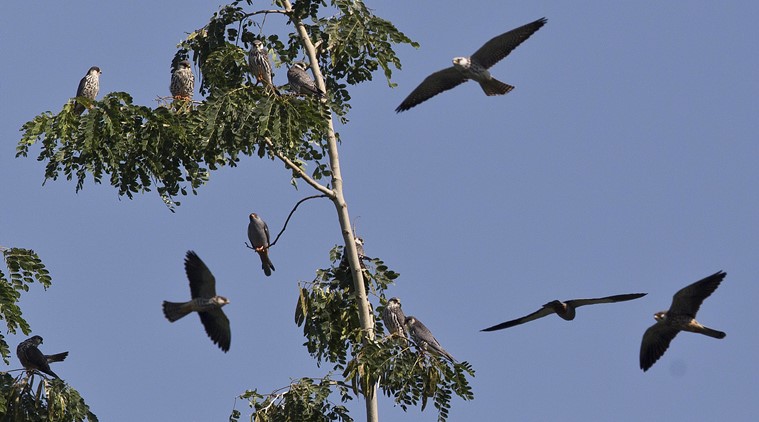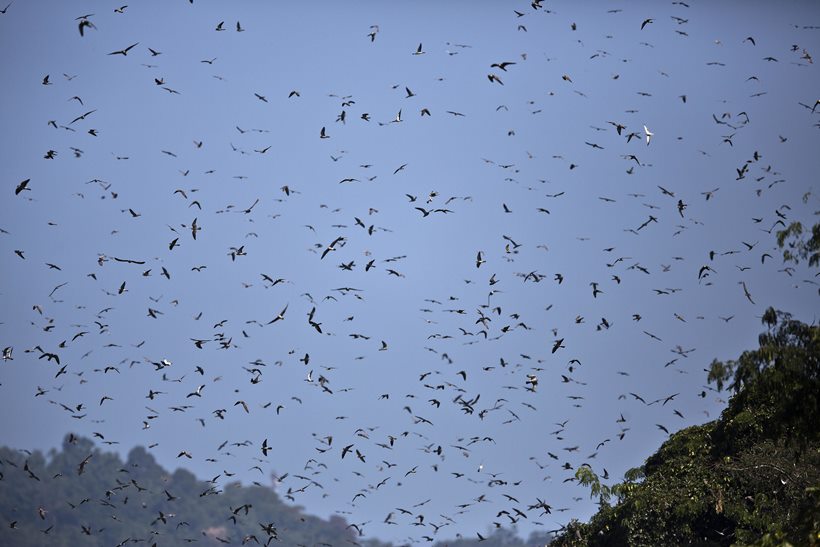- India
- International
Once target of mass hunting in Northeast, ‘Birds of God’ are now rare symbol of hope
“But what has made the project a true success was the involvement of the community. There has never been such a quick turnaround to a conservation project in India, where one year a species was being hunted and in the next, it stopped."
 After the hunt, the bird would be sold for Rs 25-30 a piece in markets, with a hunter earning anywhere between Rs 30,000-50,000 in a season. (File)
After the hunt, the bird would be sold for Rs 25-30 a piece in markets, with a hunter earning anywhere between Rs 30,000-50,000 in a season. (File)EXACTLY eight years ago, reports of around 1 lakh Amur falcons being hunted every day in Nagaland’s Wokha district, to be sold for their meat, had created a flutter across the world. The mass harvesting of the bird — with one of the longest migratory routes, from Siberia to Africa — prompted the central and state governments, and wildlife experts, to launch a desperate conservation project.
Today, these falcons symbolise a rare success story, scripted mainly by local communities. The hunting has stopped completely, say experts. So much so, that the Union Environment Ministry has decided to extend the project from Nagaland and Manipur to neighbouring southern Assam, Mizoram and Tripura, where the birds are known to roost.
From Explained | What is the Convention on Migratory Species and how does it matter to India?
Dr Suresh Kumar of the Wildlife Institute of India (WII), who led the project, says very little was known about the bird before reports of the harvesting made global headlines. “We were taken by surprise. The Environment Ministry asked for the matter to be investigated. The state government immediately banned the hunting of the bird and said they would not release developmental funds to villages involved,” says Kumar.
 As the Amur falcons come, hordes of tourists flock to Pangti and to the Doyang reservoir to savor the sight of the amazing birds. Wildlife agencies have satellite-tagged a few Amur falcons to keep track of them.
As the Amur falcons come, hordes of tourists flock to Pangti and to the Doyang reservoir to savor the sight of the amazing birds. Wildlife agencies have satellite-tagged a few Amur falcons to keep track of them.
“But what has made the project a true success was the involvement of the community. There has never been such a quick turnaround to a conservation project in India, where one year a species was being hunted and in the next, it stopped,’’ he says.

From breeding grounds in Siberia and northern China, these falcons migrate west, across the Arabian Sea, to Southern Africa, where they spend the winters. But for a period of about 10 years, during their brief stopover, around 15,000 birds were being harvested every day in Wokha. Sometimes, experts say, the numbers even went up to 1 lakh a day.
Also Read | Nagaland to S Africa in 2 months: The flight of the Amur falcon
According to local residents, the villagers would put up wide nets across bamboo forests on which the falcon would roost. After the hunt, the bird would be sold for Rs 25-30 a piece in markets, with a hunter earning anywhere between Rs 30,000-50,000 in a season.
 To celebrate the conservation story, the Nagaland government held an Amur Falcon Conservation Week and Festival earlier this month in Wokha district, 400 kilometers (250 miles) east of Gauhati. (Source: AP)
To celebrate the conservation story, the Nagaland government held an Amur Falcon Conservation Week and Festival earlier this month in Wokha district, 400 kilometers (250 miles) east of Gauhati. (Source: AP)
Jennithing Shitiri, chairman of Pangti village in Wokha, says the falcons would start arriving mid-October and leave by November-end. “They would stay for a short duration, and the villagers would make most of this time. Earlier, it was never in such large numbers. Once the nearby Doyeng reservoir came up, around 2002, the birds started roosting in millions,’’ he says.
Also Read | Manipur: Five Amur falcons to be tagged with satellite transmitters
It was not easy convincing the villagers to stop hunting, says Shithri. “What WII, the government and NGOs did was to convince the Church, the village council and student leaders. We explained the benefits of the project. Then, they started getting international recognition, which spurred them on. Now, there are eco-clubs in every school that talk about conservation and biodiversity. We started receiving domestic and international tourists, and home stays and eateries sprung up,’’ he says.
 Amur Falcons would arrive from Mongolia, Siberia Northern China and Japan, would stay in Wokha district and adjoining areas for about two months, and then take off for South Africa. (Photo: Ramki Sreenivasan/Conservation India)
Amur Falcons would arrive from Mongolia, Siberia Northern China and Japan, would stay in Wokha district and adjoining areas for about two months, and then take off for South Africa. (Photo: Ramki Sreenivasan/Conservation India)
Wokha Forest Officer Zuthunglo Patton says the project was community driven. “In Nagaland, most of the land is owned by individuals or communities — 88.7 per cent of land is privately held and 11.3 per cent is government land. So the government cannot issue a ban without the approval of the village communities,’’ she says.
Also Read | Days after killing of migratory Amur falcon ‘Manipur’, administration ban airguns
In the far-off Tamenglong district of Manipur, community leader Nehemiah Panmei of Azuram village says Amur falcons had been hunted for 40 years. “But our ancestors believed that these were sacred birds. They were called Ra Ruai or Birds of God. They believed that whenever they arrived in large numbers, it would portend a good harvest. We reminded our people of our ancestral beliefs, and explained how important the birds were for the biodiversity of the area. The Church pointed out that conservation of wildlife was also mentioned in the Bible,’’ he says.
The project was launched in Nagaland in 2013 and extended to Manipur three years later. The WII chipped in with a staggered satellite tagging project, choosing several birds from each area from 2013 to 2016. Some tagged birds have died since, some are still transmitting data. “Once the villagers realised the importance of what was being done, and their involvement in it, they were very excited. Some of them even asked for the tagged birds to be named after them,’’ says Kumar.
Apr 19: Latest News
- 01
- 02
- 03
- 04
- 05






































